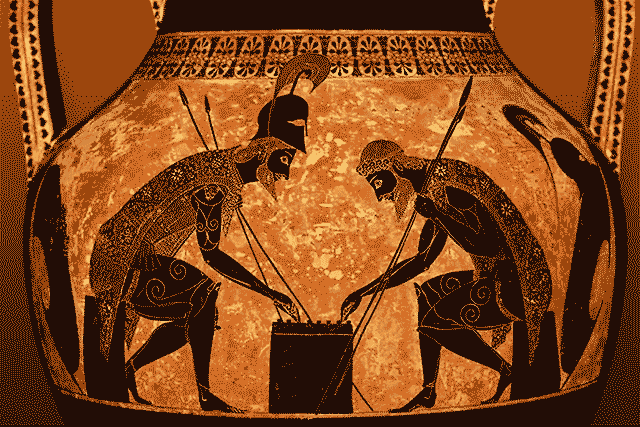#smarthistory
Explore tagged Tumblr posts
Text
youtube
A bronze Buddha’s journey, May 9,2025
Examine this bronze statue of the Buddha with us, from its green patina to its fine details. We consider how its design indicates its origins in the Khmer Empire, the journey it took across current day Thailand to Vietnam, and why it was buried. Speakers: Dr. Emma Natalya Stein, Associate Curator of Southeast Asian and South Asian Art, National Museum of Asian Art, Smithsonian Institution, and Dr. Beth Harris, Smarthistory Seated Buddha, Cambodia, 12th century, bronze, National Museum of Asian Art, Smithsonian Institution, Freer Collection, Purchase–Charles Lang Freer Endowment, F1937.29a–d. More information about this object: https://asia.si.edu/explore-art-culture/collections/search/edanmdm:fsg_F1937.29a-d/
Seated Buddha, 12th century
Angkor period, Northern Thailand
Bronze
H x W: 13.2 x 30 cm (5 3/16 x 11 13/16 in)
As early as 1898, found and excavated by an unidentified French official near Biên Hòa, Đồng Nai Province, Vietnam
With a straight spine and wide shoulders, the Buddha sits in meditation on a lobed lotus pedestal, beneath the canopy of a separately cast Bodhi tree. A flat back plate surrounds him with radiating flames and naga finials. Rows of miniature Buddhas encircle the square base. The surface is covered with a lustrous green patina flecked with blue. This sculpture was discovered along with six other Khmer bronze images that were excavated from a site in Vietnam in 1919. The group includes Buddhist and Hindu deities and ritual objects, all of which are small in scale. At less than a foot high, the Freer bronze is the largest. After a French forest ranger discovered them, the bronzes made their way into American museums in Boston, Cleveland, Philadelphia, Detroit, Kansas City, and Washington, DC. Little research has been done on the origins of the group--where the sculptures were made, how they were used, and why or how they traveled remains unknown. For centuries, portable bronze figures were instrumental in the spread of Indian traditions across Asia. The small stature of these bronzes suggests several possible purposes. Some of them may have been battle standards carried in royal or ritual processions, as relief carvings from temples in the Angkor area show such objects. The seemingly deliberate burial suggests that the group was a consecration deposit or sacred offering for a temple.
#national museum of asian art#smithsonian#buddhism#angkor empire#Thailand#Vietnam#Buddha#bronze#sculpture#religion#smarthistory#colonialism#imperialism#archaeology#art#art history#figure#YoutubeBlaze
#national museum of asian art#smithsonian#buddhism#angkor empire#Thailand#Vietnam#Buddha#bronze#sculpture#religion#smarthistory#colonialism#imperialism#archaeology#art#art history#figure#Youtube
3 notes
·
View notes
Video
#Kyoto#Temple#Painting#Screen#Japanese#Japan#Smarthistory#Art History#Art#Zen#Chinese style#1885#19th Century#Enkou-ji#Tomioka Tessai#flickr
5 notes
·
View notes
Text
Smarthistory has a great video on this piece!
youtube
talking about Rosie The Riveter, fun fact: while the We Can Do It picture has become the most-well known depiction of her in modern times, it wasn’t really a famous image when it was made–in fact, it wasn’t even intended to be her
the most famous depiction of Rosie The Riveter during WWII was probably Norman Rockwell’s painting

note what she’s resting her foot on
217K notes
·
View notes
Text
Yayoi Kusama Galeria Națională Victoria Melbourne 2024-2025
Retrospectiva Yayoi Kusama , care a fost deschisă pe 15 decembrie 2024, la Galeria Națională Victoria (NGV) National Gallery of Victoria Art museum in Melbourne, Australia transformă întregul parter cu 200 de lucrări care acoperă cariera de opt decenii a artistei în vârstă de 94 de ani și include zece dintre captivanțele ei semnături. opere de artă – un număr fără precedent într-un singur…

View On WordPress
#Bienala de la Veneția#Christie&039;s#Feminism Art#Georgia O&039; Keefe#Jackson Pollock#Louis Vuitton#Matsumoto#Minimalist art#National Gallery of Victoria Art Melbourne#New York#New York Botanical Gardens#Nihonga Kyoto#Phillips&039;s New York#Pop Art#Smarthistory#Sotheby#Tokyo#Willem Von Kooning#Yayoi Kusama#Yayoi Kusama Museum
0 notes
Text
A Beginner’s Guide to Art History
Abigail, our art history blogger, offers a beginner’s guide to exploring #arthistory with free resources like Crash Course, SmartHistory, and The Lonely Palette Podcast. Perfect for those curious about the discipline! #wherecreativityworks #MarywoodArt
As an Art History major, the biggest hurdle I have is to explain what I do to others. It’s simple in concept but the execution is a whole other story. I cannot fault anyone, I was the exact same way come my first time sitting in that darkened classroom, the neon glow of the projector absorbing the entirety of my attention. Imagine my surprise when instead of the Mona Lisa I’m looking at a cave…
#Art#Art History#Books#Crash Course#Education#Free#History#inspiration#learning#Marywood University#podcasts#Resources#smarthistory#Where Creativity Works
0 notes
Photo
youtube
Attic Black-Figure: Exekias, amphora with Ajax and Achilles playing a game, September 29, 2012
A conversation between Dr. Beth Harris and Dr. Steven Zucker in front of an Attic black figure amphora by Exekias (potter and painter), archaic period, c. 540-530 B.C.E., 61.1 cm high, found Vulci (Gregorian Etruscan Museum, Vatican). Created by Beth Harris and Steven Zucker. Smarthistory

Homeric mind is ingenuity, practical intelligence. There is no Rodin-like deep thinking, no mathematical or philosophical speculation. Odysseus thinks with his hands.
- Camille Paglia
#Gregorian Etruscan Museum#vatican museums#smarthistory#Exekias#mythology#Greek#Ajax#Achilles#Trojan War#Attic#figure#black figure ware#archaism#Vulci#art#art history#ceramic#terracotta#earthenware#Youtube#6th century bce
290 notes
·
View notes
Text
the more i think abt it the more i think the far right idea of ireland historically being this “pure” island separated from the world around it before its colonisation is just an inversion of british ideas abt ireland which cast it as this backwards place only connected to the world through british influence. and instead of rejecting that framework and investigating the ways in which ancient ireland did play a role in the broader world before colonisation, the irish far right decided that england was completely right about ireland, with the only difference being that they see this mythical isolation as the ideal to be returned to.
edit: i cant believe i have to make this clearer but this post is criticising the irish far right for their hateful and ahistorical beliefs. migration is not colonialism nor is it the cause of irelands problems. it is a morally neutral act.
#bro you are just accepting british paradigms#not to be like we live in a society but.#like do you know how involved ireland was in the transmission and reproduction of texts. do u know abt its tradition of pilgrimage#and the pilgramage sites in ireland that people visited from across the world#(i mean mostly europe and the middle east bc they were christian sites and thats where christians were. but still#but these connections predate christianity#did you know bronze age gold collars from ireland have been found throughout central europe. do you know how amber in ireland. like that in#most of ancient europe. comes from the area around ukraine#i cant emphasise enough how insane the state of the discourse is like. it seems like a lot of people really believe in this past which#never existed#sorry i watched some smarthistory videos abt ancient and medieval irish art and got mad#be quiet b
9 notes
·
View notes
Text
Nothing picks me up like a Romolini real estate video
2 notes
·
View notes
Text

Traverse Hieronymus Bosch’s ‘The Garden of Earthly Delights’ with Smarthistory
226 notes
·
View notes
Text
NOTHING AT THE LIBRARY WAHHHHHHHHHHHHHHHH
i can’t find the orignal 500 ap art history curriculum ANYWHERE its actually overr……
#going sicko mode.....#i manages to find old smarthistory pdf's of the 2013-2014 curriculum#but only as practice test so its only a few of the 500 :((#and none of em list the titles anyways
2 notes
·
View notes
Text
youtube
Oracle Bone, Shang Dynasty, October 8, 2016
Oracle Bone, Shang Dynasty, Reign of Zu Geng, c. 1191-1181 B.C.E. (Shanghai Museum, China) Speakers: Dr. Kristen Chiem and Dr. Beth Harris.
Smarthistory
#art#art history#shang dynasty#calligraphy#oracle bone script#Shanghai Museum#Chinese#Smarthistory#history#pictogram#2nd millenium bce#Youtube#Ghost Festival#盂蘭盆#鬼節#中元節
5 notes
·
View notes
Video
#Portuguese#Good Shepherd#1650#Goa#ivory#Victoria and Albert Museum#V&A#London#South Asia#India#Sculpture#Smarthistory#Art#Art History#Baroque#flickr
1 note
·
View note
Note
Hello, may I have a question? Of course, only answer it if you have time. Since you love art and share a lot of paintings I've come to you with my inquiry. Do you know any site on the net where people could look up the descriptions/interpretations/analyses of different paintings? Since every painting carries a lot of hidden meaning it would be interesting to find explanations. I would be especially interested in finding out which Muse is which one on the painting by Henrich Maria Hess - Apollo and The Muses. I've done Google searches many times but couldn't find any meaningful description. Thank you so much for taking the time to read my question.
This is a really good question. I confess that I'm a little bit of a dinosaur in this regard -- I tend to go to printed books for things like this -- but as a starting point, you might try The Art Story or Smarthistory, both of which deal with art analysis and interpretation. If you have a good library nearby, you might also see whether they have a copy of The Oxford Guide to Classical Mythology in the Arts, which has a narrower focus on what you're looking for. I hope this is at least somewhat helpful.
21 notes
·
View notes
Note
hello miss terra!! i was wondering if you had any recs for other little internet corners that are art historian approved like your blog? like other blogs, substacks, newsletters, yt channels, etc. its just so fun to see you history posting but its rare to find these types of niche more light hearted places on the internet that arent run by people that think european peasents ate potatos and every painting with realistically painted people is from the renaissance :(
no I've never found any art historian community online due to a mix of competitiveness, elitism, possessiveness with our research, imposter syndrome, jealousy, and rigidity within specailizations. it's not like classics where everyone works together. it's radio silent. people who aren't top experts in the field with 20 per reviewed publication reeeeally don't like talking and sharing ideas. 0 of my friends or mentors post about their research or life, they only brag through a weird proxy like on linkedin or smarthistory or via their star students. one of them is a leading high renaissance expert and you wouldn't know if you aren't connected to the sistine chapel or italian scholarship conference circuit.
there are a FEW influencers like katy hessel and mary mcgillivray who have gained a following for their mini lectures and of course millions of hobbyists posting incorrect content. but it's rare to see anyone with PhDs putting their work out there on the lower level.
and peasants definitely eat potatoes in Europe lol! (tho I guess you meant medieval times)
13 notes
·
View notes
Text
the smarthistory people on youtube are saving my life. do you think they can get me a three on the exam 😭
3 notes
·
View notes
Text
youtube
Have you ever wondered why two large owls sit on either side of the central panel in “The Garden of Earthly Delights” by Hieronymus Bosch? Or perhaps you’ve noticed the strangely fleshy, sculptural fountains rising from the bodies of water—or are they stone? Why is the right side so dark, and who are all these people anyway?
Narrated by Dr. Beth Harris and Dr. Steven Zucker, Smarthistory’s latest video tours the uncanny landscapes of Bosch’s famous triptych, which continues to “confound our expectations of Christian art of the Renaissance.”
3 notes
·
View notes

